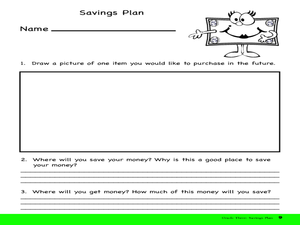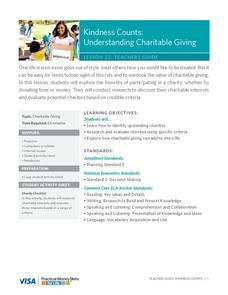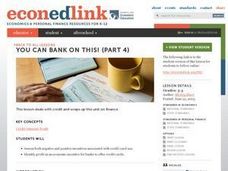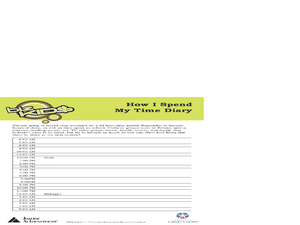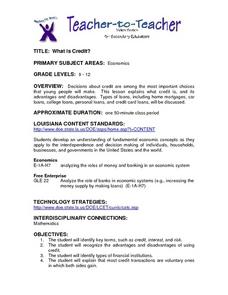Curated OER
Savers & Borrowers: Financial Markets in the United States
Investigate the current financial market and have your class explore savings, borrowing, financial markets, mutual funds, and the stock market. This four-part instructional activity is designed to help learners become knowledgeable and...
Curated OER
Having a Savings Plan
Learners discover the importance of saving and spending. In this finance lesson, students read the book Kermit the Hermit and discuss the differences between needs and wants. The learners complete worksheets concerning money in their...
Curated OER
Interest Rates
Use a KWL chart and discussion to explore the concept behind loans with interest based on percentage rates. Learners examine different types of interest, the history of interest loans and calculate the costs of a loan over a ten-year...
Visa
Kindness Counts: Understanding Charitable Giving
Financial literacy is generally focused on personal spending and saving, but consider an opportunity to talk to your pupils about how charitable giving can also factor into money management and how it can enhance life for both oneself...
Curated OER
Saving Strawberry Farm
Students explore U.S. History by analyzing the Great Depression. In this economic instability lesson, students read fictitious accounts of a farm dealing with the loss of a Strawberry Farm and discuss the reasons behind the loss....
Curated OER
Teaching Economics Using LUNCH MONEY
Students, after reading the book "Lunch Money" by Andrew Clements, explore money and different saving places. They research different ways in which productivity has increased over the years, they examine products to determine if the...
Council for Economic Education
You Can BANK on This! (Part 4)
Students assess both negative and positive incentives associated with credit card use. They identify profit as an economic incentive for banks to offer credit cards.
Curated OER
How to Achieve Your Financial Goals
Learners explore economics by creating a budget. In this financial goal setting lesson, students investigate their use of time by completing a worksheet. Learners identify financial goals they would like to achieve in the next several...
Curated OER
Smart Consumers, Smart Choices
Students see what it means to be a smart consumer by engaging in a level-headed analysis of budget, opportunity costs and self-regulation. They compare prices within a service field, and weigh the choices of spending money on that item.
Curated OER
Reno's Dilemma
Students explain proportions as it relates to principle and interest. They use proportions to explain relationships and analyze relationships by identifying patterns.
Curated OER
What is Credit?
Students listen to a guest speaker discuss credit, and what lenders look for when approving loans. They investigate savings and loans, banks, credit unions and finance companies to find out what A.P.R. they charge for certain items.
Curated OER
Potato Ways
Pupils analyze the packaging process. In this consumer awareness lesson, students analyze the process of packaging a potato and identify positive and negative ways of packaging. Pupils study statistics on an overhead transparency to...



